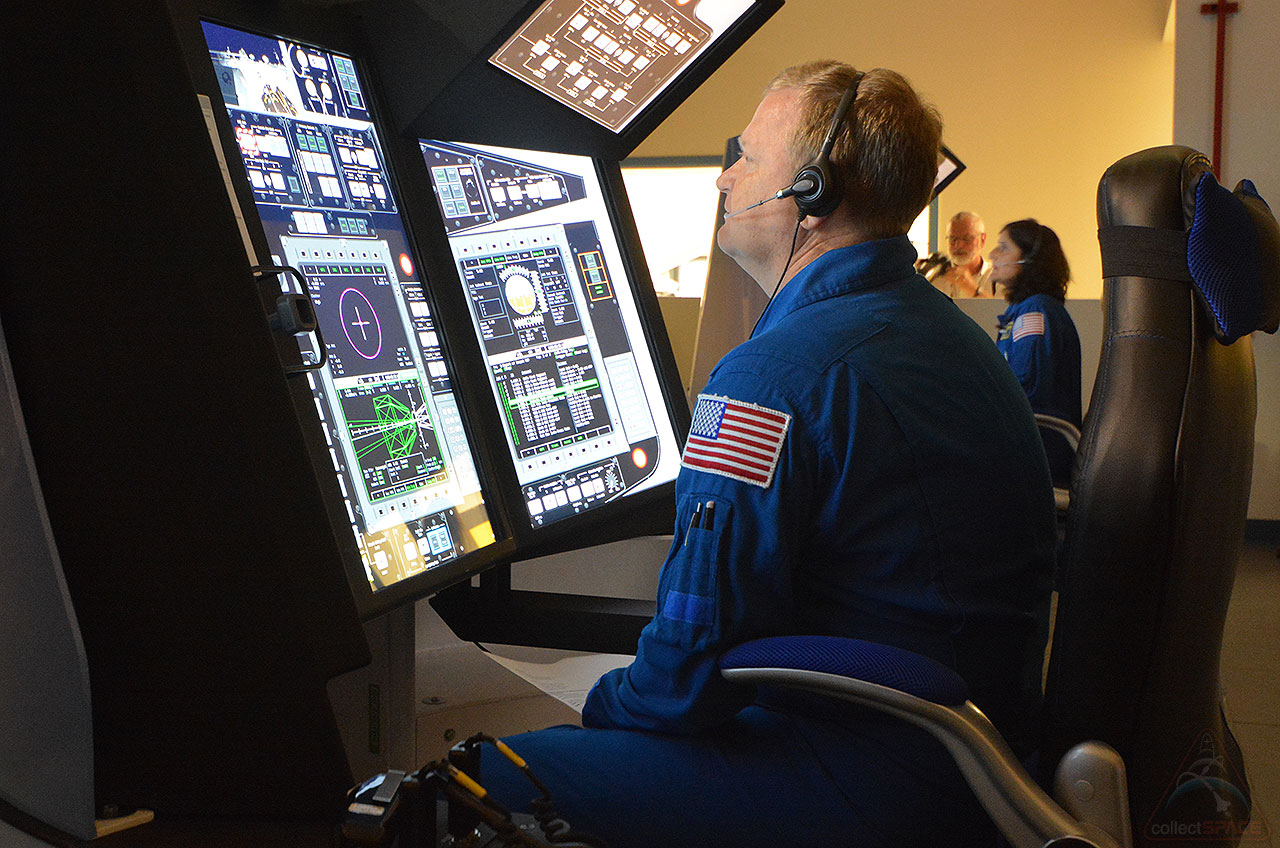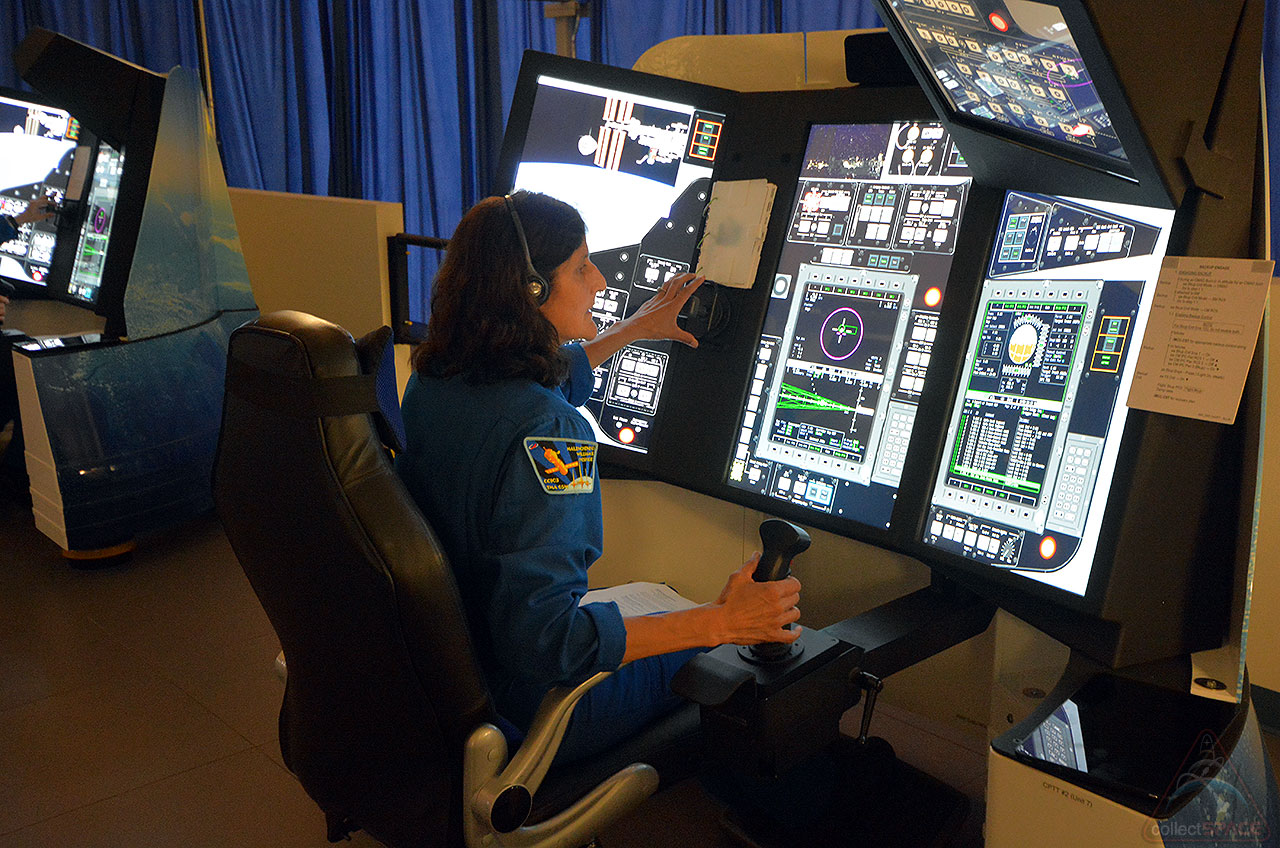Starliner Simulators: Astronauts 'Fly' Boeing Spacecraft Trainers

ST. LOUIS — With the flick of a few virtual switches and the use of a control stick, two NASA astronauts undocked Boeing's new commercial spacecraft from the International Space Station on Tuesday (April 26) — until thunderstorms over St. Louis cut the simulation short.
The (real-life) weather aside, astronauts Eric Boe and Suni Williams said their simulated spaceflight experience was a success as they concluded the acceptance evaluations for the two CST-100 Starliner Crew Part Task Trainers (CPTT) at Boeing's St. Louis facilities.
"Although [the thunderstorm] was making a lot of noise, we completed what we expected to do," stated Boe, who with Williams and astronauts Doug Hurley and Robert Behnken comprise NASA's first "cadre" of commercial crew trainees. "It was a good day." [Boeing's Private Space Capsule: CST-100 (Infographic)]
"This is really exciting for our country and space program," said Williams. "We're back creating spacecraft and rockets in this country and launching them from this country, which I think is really exciting."
In September 2014, NASA selected Boeing as one of two U.S. companies to provide commercial launch services for its space station-bound crews. The space agency awarded a total of $6.8 billion, including $4.2 billion to Boeing for it to complete and certify the CST-100 Starliner for flight and $2.6 billion to SpaceX to do the same with its Crew Dragon capsule.
Boeing is building the Starliner to fly atop a United Launch Alliance Atlas V rocket from the Cape Canaveral Air Force Station in Florida. At the end of its mission, the capsule will return under parachutes and deploy airbags to cushion its touchdown in the southwestern United States.
To date, NASA has ordered its first two Starliner missions, to follow Boeing's test flights to the space station. The first piloted test, targeted for late 2017, will be crewed by either Boe, Williams, Hurley or Behnken and a Boeing test pilot, who has yet to be selected.
Get the Space.com Newsletter
Breaking space news, the latest updates on rocket launches, skywatching events and more!
"My background is as a test pilot, so testing new airplanes and equipment is great but testing new spaceships — well, we here in the United States haven't tested a new manned vehicle for 30 years, so it's a real honor to get the chance," said Boe.

Likened to driver's ed or the use of training wheels before riding a bicycle, the CPTTs are each capable of replicating all of the mission phases and flight conditions that the crew members may encounter as they fly to and from the space station. Together with the Boeing Mission Simulator (BMS), a full-size immersive mockup of the CST-100 Starliner still in development, the CPTT simulators comprise the primary means that the astronauts will use to be ready to fly on the real capsules.
"Here [with the CPTT] you're not learning the full-up, if you will, muscle memory of where every switch is [located] and what each is going to feel like, but you're learning what the switches are, what the displays are, what they look like and what they do," said Pete Meisinger, the manager for space vehicle training programs at Boeing. "Anything that the astronaut can press, hear [or] look at is represented in these devices."
"These are touch screen versions of the real cockpit," said Chris Ferguson, deputy manager and director of crew and mission operations for Boeing's commercial crew program. "They're able to emulate an entire mission from beginning to end."
"The only real difference between these and the cockpit is a lot of the real cockpit switches are hardware and [here] they are relegated to a touch screen," said Ferguson, who as a NASA astronaut commanded STS-135, the last space shuttle mission, in 2011.
The touchscreen design of the CPTT stations make a wide array of scenarios possible, from individual training runs to more complex sims where Mission Control can be tied into the training exercise.
The astronauts and flight instructors have been coming to Boeing in St. Louis over the past six months to help refine the simulators for their use in training crews to fly the CST-100 Starliner.
"It is nice for us to bring our experience and expectations [into] discussions about how the cockpit is going to be laid out, how the vehicle is going to fly manually, and just our understanding of the new spacecraft," Williams explained. "I think they're very open to our input, particularly because of the experience we have."
With the astronauts evaluations complete, Boeing will next prepare both CPTT simulators, their instructor stations and the servers that power them to be delivered to the Johnson Space Center in Houston, where they will be put into use at the Jake Garn Training Facility. Ferguson said it will take nine months of using the task trainers and BMS to qualify an astronaut to launch on the Starliner.
"Hopefully in July, early August, we'll have a great closed-loop training system for astronauts and flight controllers, which is the first step towards getting back into low Earth orbit and servicing the International Space Station," stated Ferguson.
Watch a video about Boeing’s CST-100 Starliner Crew Part Task Trainers at collectSPACE.
Follow collectSPACE.com on Facebook and on Twitter at @collectSPACE. Copyright 2016 collectSPACE.com. All rights reserved.
Join our Space Forums to keep talking space on the latest missions, night sky and more! And if you have a news tip, correction or comment, let us know at: community@space.com.

Robert Pearlman is a space historian, journalist and the founder and editor of collectSPACE.com, a daily news publication and community devoted to space history with a particular focus on how and where space exploration intersects with pop culture. Pearlman is also a contributing writer for Space.com and co-author of "Space Stations: The Art, Science, and Reality of Working in Space” published by Smithsonian Books in 2018.In 2009, he was inducted into the U.S. Space Camp Hall of Fame in Huntsville, Alabama. In 2021, he was honored by the American Astronautical Society with the Ordway Award for Sustained Excellence in Spaceflight History. In 2023, the National Space Club Florida Committee recognized Pearlman with the Kolcum News and Communications Award for excellence in telling the space story along the Space Coast and throughout the world.










